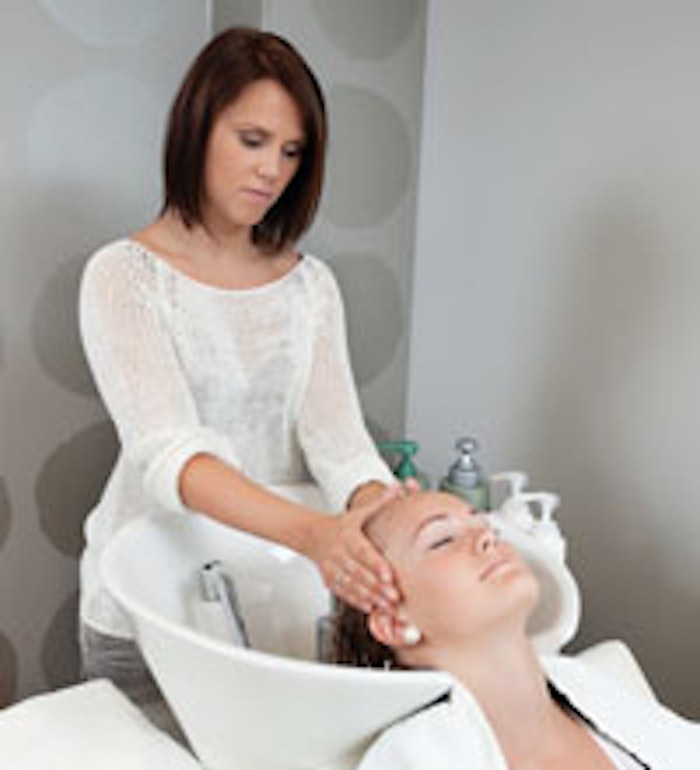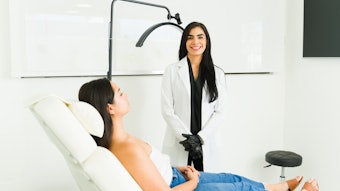
Are skin care professionals missing an opportunity by not treating the skin north of the forehead? If you subscribe to the notion that the scalp, too, is indeed skin, then the answer is “yes.”
Dedicating attention to the scalp can provide skin care professionals with an element of differentiation in the sea of competition that exists in the spa industry, and it serves as a great ancillary service to bolster the spa menu and your bottom line.
In recent years, the scalp has been receiving more attention as skin care professionals realize that the same methods and ingredients used for skin care may also be used to treat dehydrated, oily, depleted and aging scalps. Correcting these conditions improves the look, feel and overall health of the scalp and, thus, the hair. So why are esthetic professionals stopping at the hairline?
Why treat the scalp?
Scalp treatments need not be relegated to hairstylists and specialists. Many clients, whether they vocalize it to their estheticians or not, typically want to improve the condition of their hair. They may be concerned with hair loss, dry scalp, hair damage or an overall aging of the hair.
The scalp and hair have a lot more to contend with these days. In addition to the free radicals from environmental elements such as sun overexposure and pollution, the surge in hair coloring, highlighting, blowouts, straightening and perming make the scalp and hair more susceptible to damage. Similarly, buildup from styling products, such as gels, mousses, balms and volumizers also may create dry, oily and congested conditions.
Like the rest of the body’s skin, the health of the scalp is impacted by intrinsic and extrinsic factors. Intrinsic might include medical conditions, diet and lifestyle, and extrinsic includes hair products and environmental elements, to name only a few. For instance, if the scalp is inflamed as a result of a medical condition or because the follicle is clogged with dead cells and bacteria, the hair may become weaker or grow thinner.
Similarly, the scalp ages much like the rest of the skin. It can lose tone and elasticity, and cell production may decline over time. As the scalp ages, the hair weakens. It is part of the life cycle of the hair follicle, but that lifespan can be extended when the same methods and ingredients for skin care are applied to the scalp.
Since the scalp is skin, it makes sense that many of the cosmeceuticals used to maintain skin health produce similar benefits when applied to the scalp and hair.
Understanding the hair follicle
Although overall skin structure is fairly continuous throughout the body, its characteristics vary slightly on the scalp. For instance, the scalp contains more hair follicles than anywhere else on the body; has some of the thickest skin on the body; and also holds numerous sebaceous glands.
The sheer number of sebaceous glands and follicles on the scalp alone points to the need to dedicate special treatment to this area. The sebaceous glands produce oil to protect the hair, but if oil builds up, the follicle may become clogged or dandruff may be produced. Dandruff is a result of bacteria trapped in the oil, which causes itching, inflammation and increased cell turnover. This is when flakes of dead skin become apparent.
Take a closer look at the follicle, where healthy hair starts. It is made up of the hair bulb, inner root sheath and hair shaft. When this becomes clogged or damaged by intrinsic or extrinsic factors, hair may become weak, thin and appear damaged.
Nutrition both inside and out is vital to correcting—or better yet, avoiding—disruptions. Internally, healthy hair thrives on micronutrients, including vitamin B, amino acids and proteins. Externally, the hair and scalp need a system of preventive and corrective care that includes cleansing, strengthening, building and restoring. Together, these factors help support healthy hair cycles, which include the anagen phase, catagen phase and telogen phase.
Although blood vessels supply the follicle with much of its nutrients, topical formulas can also provide a boost of nourishment, especially if the blood vessels aren’t supplying an adequate amount or if disease is an issue.
Common scalp- and hair-damagers, and cycle-disrupters include:
- Diseases, such as psoriasis, and illness;
- Stress;
- Thyroid diseases and hormones;
- Nutritional deficiencies;
- Medications and surgery; and
- Extrinsic factors, such as sun overexposure, pollution, wind, styling products and chemicals.
So, how do skin care professionals help clients combat these issues?
Esthetics of the scalp
Keratin and mitochondria are two primary components of skin and hair. Keratin is the fibrous protein that forms the essential structural material of the outer layer of the skin, hair and nails. These chains of polypeptides are also a major component of the hair’s inner and outer root sheaths and shaft.
The mitochondria, the cell’s powerhouse, serve as a digestive system of sorts, regulating the intake and breakdown of nutrients to create energy for the cells. Supporting the mitochondria and keratin is vital in maintaining skin and hair health.
Excess damage to the mitochondria can result in apoptosis, or cell death, a characteristic of aging. When mitochondrial damage occurs, the skin loses tone and may become thin, and abnormal collagen accumulation can occur. This also applies to the scalp, which, in turn, impacts the hair. Similarly, keratin damage can occur through the intrinsic and extrinsic factors discussed earlier, as well as a lack of proteins and amino acids.
This is where skin care professionals come in. It is now known that many of the ingredients traditionally used in the treatment room also have the power to inhibit the progression of hair damage and loss by stimulating mitochondria, supporting keratin and fighting free radicals. Some of these ingredients include the following.
- Enzymes and proteins. Specialized complexes of panthenyl ethyl ether, milk protein, lactose, inositol, acetylcysteine and methionine will work to stimulate protein biosynthesis and cell vitality, increase energy production in scalp tissue and anchor hair to the root. Hydrolyzed lupine protein also works to slow hair loss and encourage nutrient assimilation to help hair growth.
- Peptides and amino acids. Ingredients, such as kino bark (Pterocarpus marsupium) improve hair density, increase the number of follicles, help prevent scalp disorders, and stimulate the cells that improve root anchoring and strength.
- Antioxidants. Thioctic is a powerful dual antioxidant that maintains protection of extracellular proteins, fights free radicals and limits lipid oxidative degradation.
- Vitamin B. Inositol, part of a complex that stimulates protein biosynthesis and cell vitality, proliferates cell growth and increases energy production.
- Organic plant stem cells.The portion of the plant responsible for development and life is also extremely effective in human cell regeneration and maintaining healthy hair.
Other beneficial ingredients in treating the scalp and hair include spin trap, coenzyme Q10, thiotic acid, adenine and acetylcarnitine. When used in combination, these have the ability to increase mitochondria function and longevity in both the skin and hair, as well as promote stronger, thicker and fuller hair.
Treating the scalp
When thinking about the scalp as skin, suddenly the canvas becomes larger and skin care professionals have a tremendous opportunity to expand the art of esthetics to help clients maintain total skin health. Clients come to you for skin issues on a regular basis, yet most skin care professionals tend to stop at the hairline. It’s now time to start thinking of the scalp as a natural extension of what you do.
Just as with skin issues, thinning or damaged hair can have a significant impact on clients’ spirits. Why not be there with the right tools and knowledge to help them achieve their desired results and, in turn, boost their confidence and overall well-being?
While the client is in the treatment room, you can naturally transition into a conversation about scalp treatments. For instance, when talking to clients about their skin goals or during the intake evaluation, consider asking about what they use for hair care. This also works during scalp massages or while putting on their hair bonnet. Other ideas to help transition into this topic of conversation naturally include the following:
- Take notice. If you notice acne or other skin issues spreading beyond the hairline, discuss possible treatment options.
- Visual triggers. Place diagrams of the hair structure in your facility or room with a tagline such as: “Scalp is skin, too.” Consider displaying hair care products in your facility with informational brochures about scalp and hair health.
- Listen. Your client may already be talking about hair loss or excessive damage; listen to the cues.
- Team up. If you work in a salon with hairstylists, see if they might be willing to cross-promote or partner on a total hair care program.
Get creative in your offerings and the way you promote your new services. Chances are, clients will be so surprised you are offering hair and scalp treatments, they will automatically inquire.
Treatments may vary significantly based on your client’s goals, and the tools you have access to in your treatment room. If you have a shampoo bowl, begin with a deep cleansing shampoo gently massaged into the scalp to initiate exfoliation. After the shampoo is rinsed, apply a conditioning mask or deep conditioner, massaging for several minutes. Wrap the hair in a warm towel and allow the client to relax. After it’s rinsed, spritz with an energizing peptide formula and apply a scalp serum.
If you are without a bowl, you can still offer a wonderful add-on scalp massage for a small upcharge. Spray the hair with warm water to moisten; pat with a towel; apply a generous layer of nutrient-rich scalp serum, working it into the hair with the fingertips; moisten hands with grape seed oil and antioxidants then massage it into the scalp; and wrap the hair in a heated towel. Clients may leave with the nutrients in their hair or if your facility has a shower, they may shampoo and finish with a strengthening peptide spray.
Stand out
The more expertise and specialized services you can offer your clients will make you stand out among the competition—one of the most essential components of client retention. Offering scalp treatments is an excellent place to start. Not only are scalp services fairly unique, they may also prove to be in high demand in your facility.
GENERAL REFERENCES
en.wikipedia.org/wiki/Mitochondrion
www.salonweb.com/pro/damage.htm
emedicine.medscape.com/article/834808-overview
(All accessed Dec 5, 2012)

Rhonda Allison, a pioneer in the skin care industry, is the founder and CEO of Rhonda Allison Cosmeceuticals and RA for Men. She is also an author and internationally known speaker with more than 30 years of esthetic experience.










